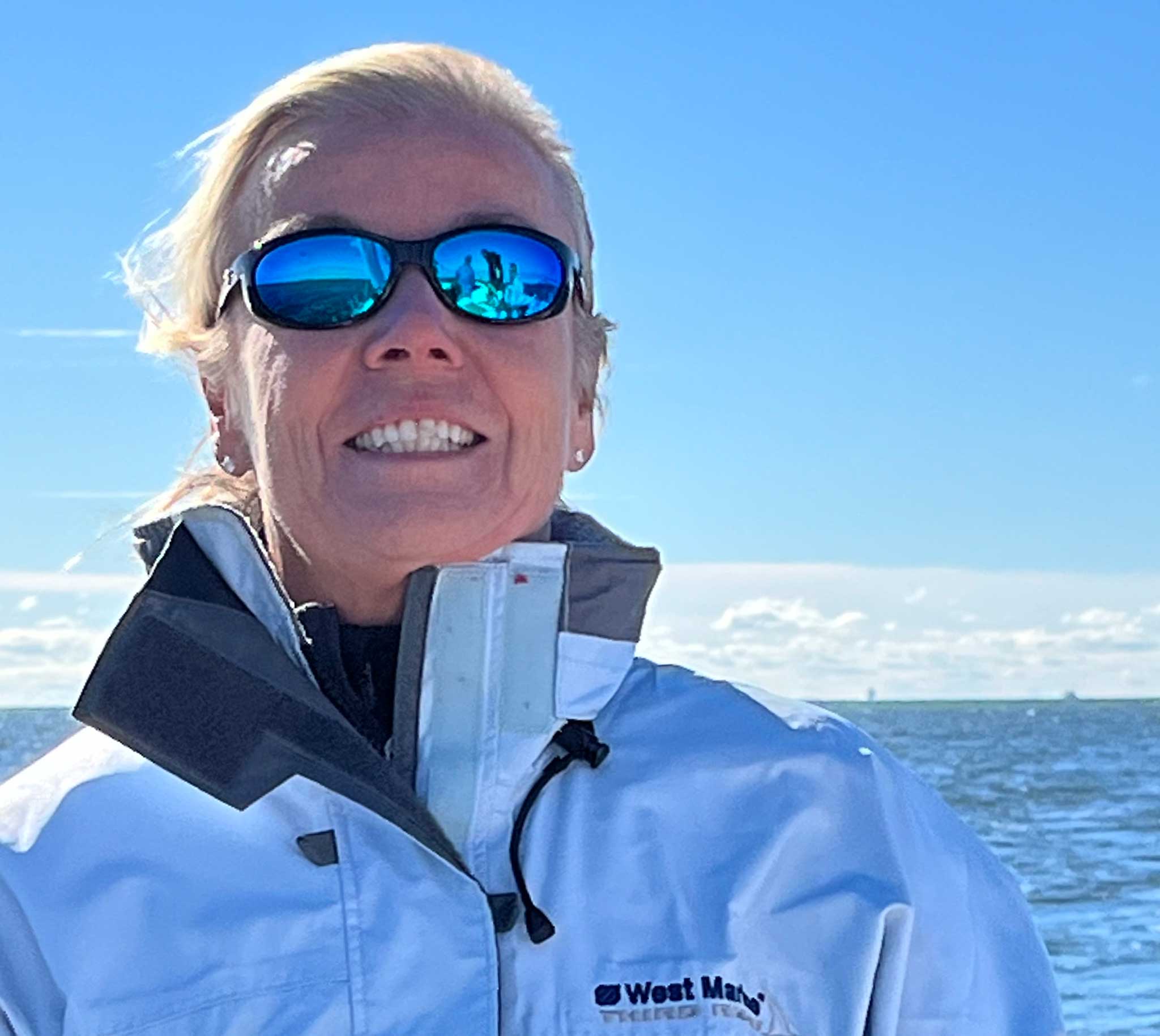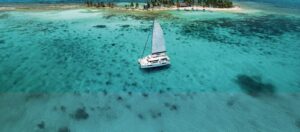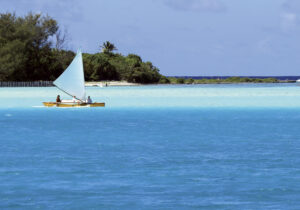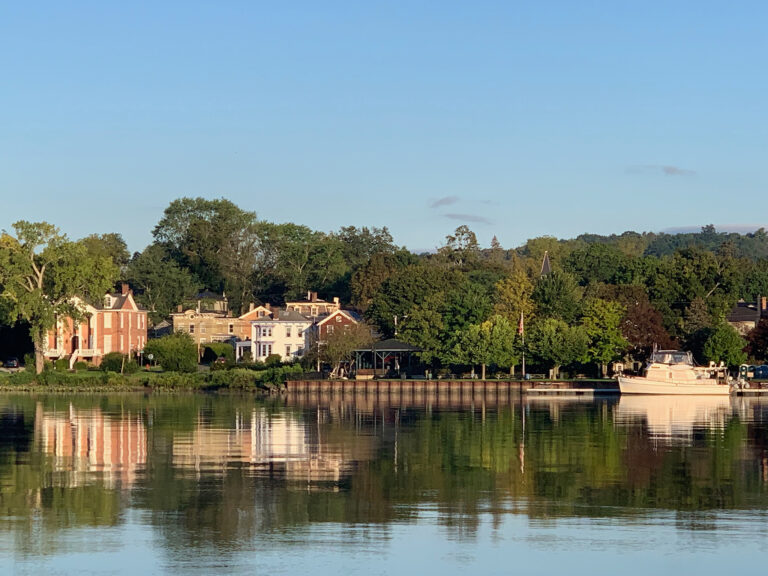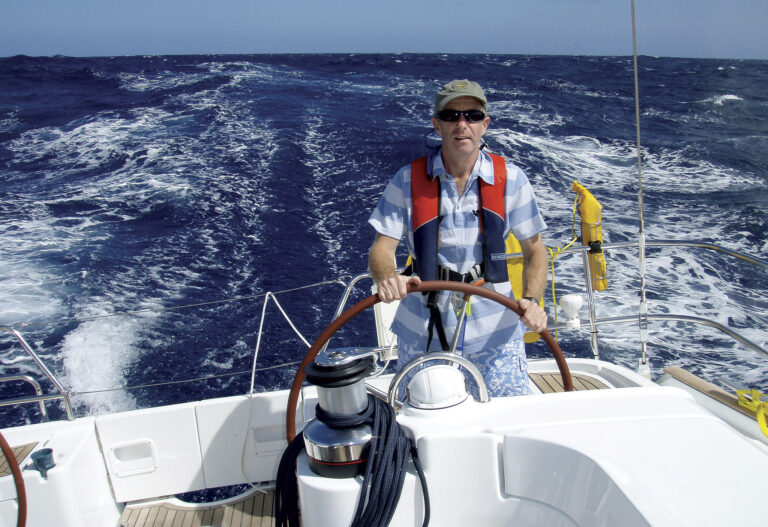The problem with going down 411 steps is that you must go back up them, because there are no elevators in a cave. Spelunking doesn’t usually come to mind on charter, but we were following in the footsteps of Lord Byron and loads of European royalty by exploring this 300-foot-deep, 45-million-year-old cave on the small island of Antiparos, in the heart of the Greek Cyclades Islands. It was worth the exertion.

After the most exercise we’d had in over a week, we treated ourselves to lunch at the Rooster Wellness Center on the island’s western shore. I was a little surprised they let our sweaty motley crew in. This is the kind of spa resort where the staff wear silk pajamas and speak in hushed tones about hot stone treatments. The beautiful grounds are right out of an architectural photo shoot, the cuisine is all organic, the cocktails are works of art, and the ocean view will make you want to move in for however long your credit card holds out.
We were halfway through our two-week Cyclades charter, and it was clear that we’d barely made a dent into the 30 or so major islands in this group. Scattered like gems across the Aegean Sea, the Cyclades comprise more than 200 islands and islets lying southeast of mainland Greece. We had started from the Agios Kosmas Marina south of Athens. Our Lagoon 42 Hathor from Navigare Yachting had just arrived from its delivery in the south of France. She still had that new boat smell.

After a majestic beam reach from Athens, we reached Kolona beach on the island of Kythnos. This is only the second island down when heading south from the mainland, and it made a great overnight stop as we tucked in behind the beach that’s protected from the north and the west.
The next day had us reeling off the miles on a glorious sail down to Milos Island, where the Venus de Milo is said to have been unearthed by a farmer around 1820 (it’s rumored she still had her arms back then before they were lost in an ownership scuffle). My friend Frank Blanc and most of his family were the crew on this trip, and although the sail was fantastic, Frank never misses a chance to feed the fish when the wind is up. He has the best attitude about seasickness of anyone I’ve ever met.
The main town on Milos is Adamas, and after Med-mooring on the quay, we strolled the circular harbor, watching vendors flog their boat excursions to landbound hotel tourists. Anthony Quin’s Zorba the Greek would have fit right in among these handsome entrepreneurs whose pitches included a cruise down the western side of the island with lunch and unlimited ouzo, vessel capacity limits be damned. They were packing 20-plus people on 40-foot monohulls with “room to spare” as they said.
We had seven people on a 42-foot cat, so we chose a different path, forming a plan based on the vendors’ brochures I picked up in town. With free-flowing grappa, I planned our circumnavigating itinerary from the waterfront village of Klima on Milos’ western side, where every shack is painted a different color and small fishing skiffs dance on moorings nearby.

The next morning, we waited two hours after the tourist boats departed and then followed them, arriving at each site just as they were leaving for the next. First stop—the roofless cave of Sikia where we anchored and dinghied in, having the place to ourselves. The ceiling of this cave collapsed eons ago leaving a lovely ring of light above.
We continued to Kleftiko on the southwest corner of the island. It’s chock full of purple and green caves and rock formations that had us dinghying and swimming the rest of the afternoon. There is no town nearby and no way to get here other than by boat, so once the tourist boats returned to Adamas, we settled into a blissfully silent anchorage where zero light pollution had us ogling the stars for hours.

No visit to Milos would be complete without a stop at the white moonscape of Sarakiniko, where sheer white cliffs fall into blue-green water and the edges are dotted with pink caves. It’s a weird place that looks like an intergalactic movie set. Ashore, buses disgorged hotel guests, some of whom risked jumping off the high cliffs. With more than a little envy, all of them turned their cameras on us as Hathor rested majestically at anchor.
Our next stop was supposed to be Santorini, but even on a two-week charter, it’s a stretch to get there because it’s so far south. Instead, we turned back north and made our way to the islands of Naxos, Mykonos, and Delos. After the remote anchorages of Milos, Mykonos can be a shock. This is where the beautiful people come to party with the iconic windmills forming an exotic backdrop. The town is all narrow alleys with tiny restaurants shoehorned into every corner among bright bougainvillea bushes. Fashion boutiques selling everything from designer jewelry to handmade flip flops provide whitewashed steps for the ubiquitous cats that are treated like royalty as they lounge about waiting for strangers to bring them treats.

Next door to glitzy Mykonos is Delos, an island that’s basically one big archeological dig. This UNESCO World Heritage Site is arguably the most culturally and historically significant island in the entire Cyclades, mythologically the birthplace of Apollo and Artemis, with ancient stone dwellings indicating people have lived there since 3,000 BC.
It’s easier to anchor at Mykonos and take the 40-minute ferry to Delos because anchoring there is neither easy nor convenient. We had a blowy day and many of the ferry passengers didn’t fare well in the choppy seas, which was clearly nothing new since a sign on the mirror in the onboard restroom read, “Don’t vomit in the sink.”
Delos is a square kilometer of ruins of ancient homes, shops, and temples with many of the mosaics and columns still intact. Standing at the Terrace of Lions, you jump back to 1500 BC, the island’s peak as the commercial and religious vortex of the Cyclades. Spending an afternoon here is walking through mind-bending ancient history.

Over the course of our two weeks, we meandered around the Cyclades in a counterclockwise direction also stopping at Iraklia in the Lesser Cyclades and the large island of Naxos, where we shimmied into a slip so tight even the dockmaster confessed later that he didn’t know if we’d fit when he assigned it. Nothing in Greece is done quietly, so as I wiggled Hathor back along the stone wall I had an army of enthusiastic local men shouting instructions over each other in Greek—not exactly helpful, but entertaining.
It was in Naxos town where we were caught in a rainstorm so sudden and dramatic that the hilly, narrow streets turned into treacherous knee-deep rivers, and we barely held onto our sandals. The drenching didn’t put off the shopkeepers a bit. They just tossed down towels and dragged us in sopping wet to showcase their wares. The tavernas did their best to make us forget our soggy shorts with carafes of famous Naxos wine. The food on every island was spectacular and provisioning in the islands is easy, cheap, and worthy of its own foodie show. Cycladic tomatoes are renowned around Europe, and the feta and seafood make your mouth water.
Besides the sailing, the food, and the history, you can’t beat the churches and the views in the Cyclades. Everywhere are small blue and white chapels or huge ornate churches like the Agios Nektarios monastery on Aegina Island, where women must don rental skirts to enter. And you really can’t beat being anchored in Sunion with a view of the lighted Temple of Poseidon on the cliffs above.

On this, my fourth trip to Greece, I was hoping to dodge the infamous Mediterranean meltemi winds, but that was optimistic. In Greece, you sail with either a wind pushing up dust from the Sahara that gets into everything including your teeth, or you face a mean northerly called a Meltemi that can trap you in a harbor for days. Our meltemi dropped on us at Paros Island about halfway through our itinerary, and although it wasn’t particularly bad, our anchor wasn’t set particularly well.
We dropped the anchor for a Med-moor on the wall in the main town of Parikia. Almost immediately, the dockmaster tried to shoo us off and the exchange went something like this:
“I called and tried to make a reservation,” I pleaded.
“That number doesn’t work!” he barked between deep draws on his cigarette. “You should call my cell.”
“How was I supposed to get your cell number?”
“By coming here!”
“What?!”

It took a lot of smiling and a few humbling apologies, but it became clear that with enough attention and adulation, he would let me pay the fee and stay. Of course, in the hubbub, we didn’t do the best job of setting the anchor, which really didn’t seem to matter on this lovely day with little breeze. We watched the big fuel truck masterfully maneuver down the narrow dock to service all the cruisers and then went into town to explore the Holy Shrine of the Virgin Mary Ekatontapyliani, a renowned pilgrimage church which has the added benefit of being near a few great tavernas.
By the next morning, the weather was less lovely, and as our anchor inched backwards, we started squishing the fenders on our transoms in a building meltemi. By then we were well wedged in by boats on either side. Every skipper on the quay was on deck nervously inspecting their lines, and the waves from the huge ferries maneuvering on the next dock over didn’t help set anyone at ease.
The German boat next to us decided they were on a schedule and had to leave, which seemed nuts given the circumstances. They asked to tie to us while they crept out into the howling wind. I refused, pointing to my anchor and saying, “Es ist nicht gut.”
All watched in horror as their boat bounced its way out, coming to rest briefly on their other neighbor’s anchor chain. But once they’d gotten out, I had room to make a run for it too. With impressive coordination of the crew, we dropped our stern lines and made haste with both engines pushing as fast as the windlass could take up chain. We anchored again a few hundred yards out, and after making damn sure we weren’t dragging, we rented a car and set out for Antiparos and that wonderful cave.
The Cyclades are exceptional, but they’re not for first-time bareboat charterers. The weather can get big in a hurry, the distances are greater than in other Greek island groups, and navigation can be comedic since each island has at least two names with five spellings—and that’s before we even get into the mindboggling Greek alphabet.
“It’s easy to sail south,” chuckles Jesper Rönngard, founder of Navigare Yachting, which provided our lovely yacht. “The trick is getting back north!”
It’s a stretch to do many of these islands in less than two weeks, but if you have the time, the Cyclades, which run roughly northwest to southeast in the eastern quarter of the Med, are absolutely not to be missed. I know it will take me at least three more trips to feel like I’ve even scratched the surface here. I might skip the steps in the cave next time, but I definitely won’t miss the cocktails at the Rooster.
Bareboat Charter in the Med: The Rules
If you want to bareboat in Greece or anywhere else in Europe and the Med, it pays to start planning early when it comes to getting the certifications you’ll need. Examples of acceptable certifications/experience are: RYA Day Skipper Course or above; International Certificate of Competence (ICC, international), prerequisites RYA Day Skipper Course or similar/equivalent certification from any recognized sailing school; International Proficiency Certificate (IPC, American), prerequisites ASA 104 or US Sailing Bareboat Cruising Course.
As a bareboat skipper in Europe and specifically in Croatia and Greece, you must complete an online application, submit your sailing résumé, and add a basic cruising certification as listed above.
It takes time to complete the necessary coursework, but you may be able to challenge the test and still receive an IPC, which is good for five years and then can be renewed for a fee. Contact ASA or US Sailing directly for specifics and pricing, since many independent schools quote prices based on selling classes that you may not need.
The key is to start early so you have time to acquire the required documentation and experience before committing to a charter. If you arrive without the necessary documentation, the charter company may be required to assign you a local skipper at your expense.
April 2025

